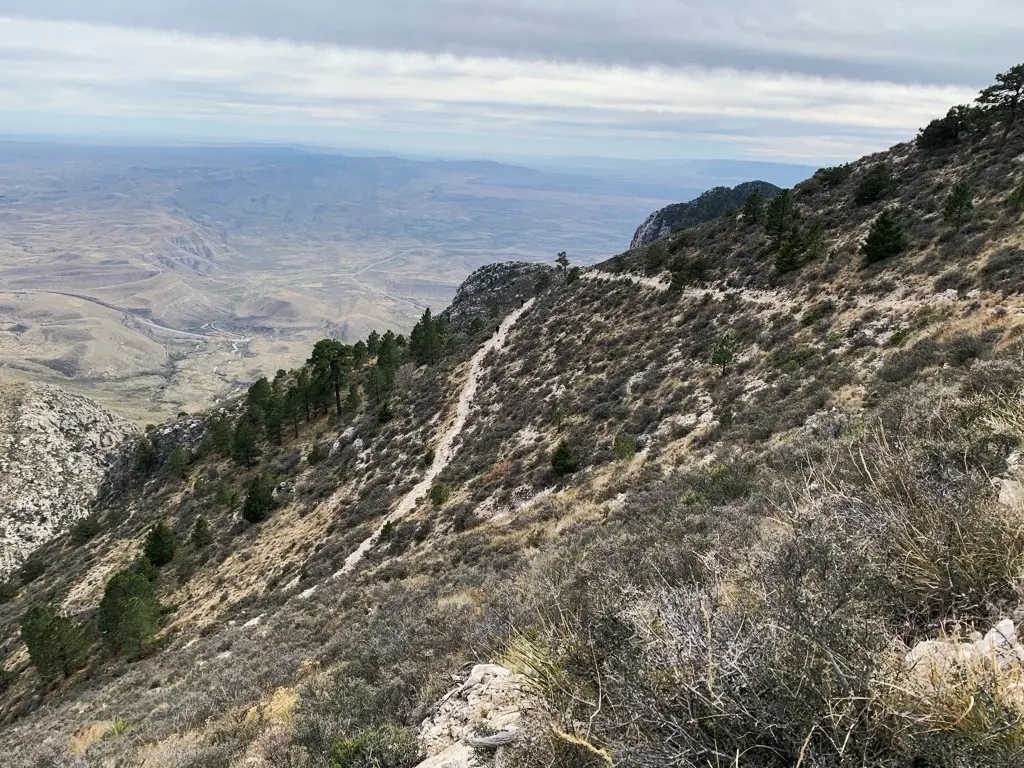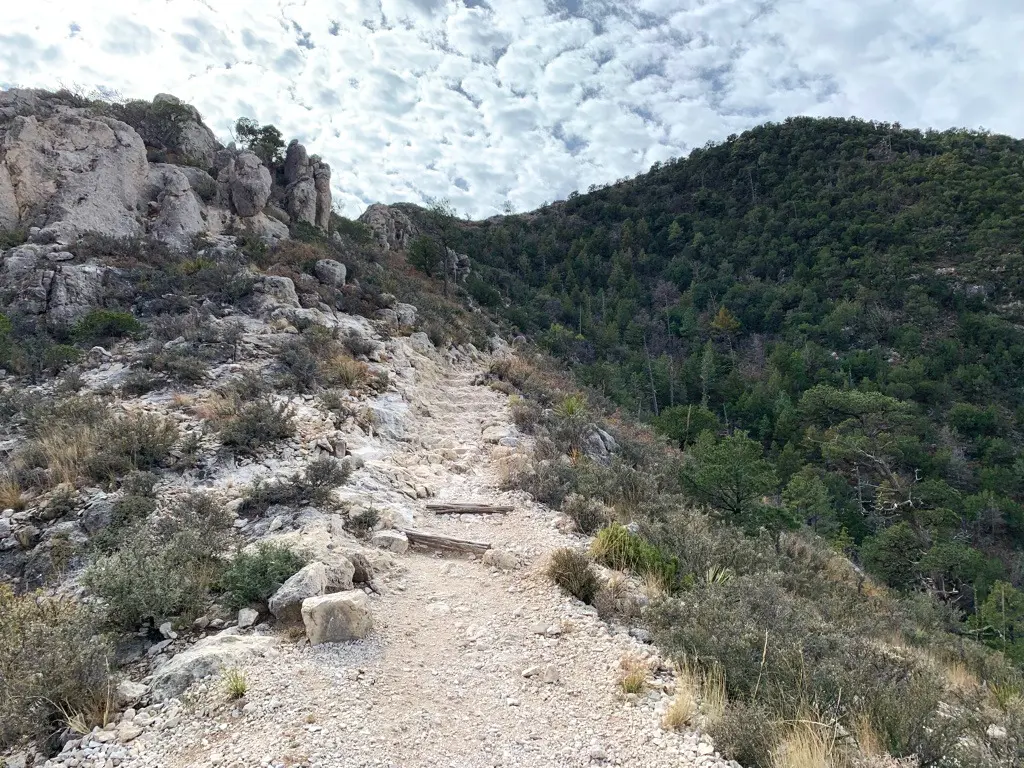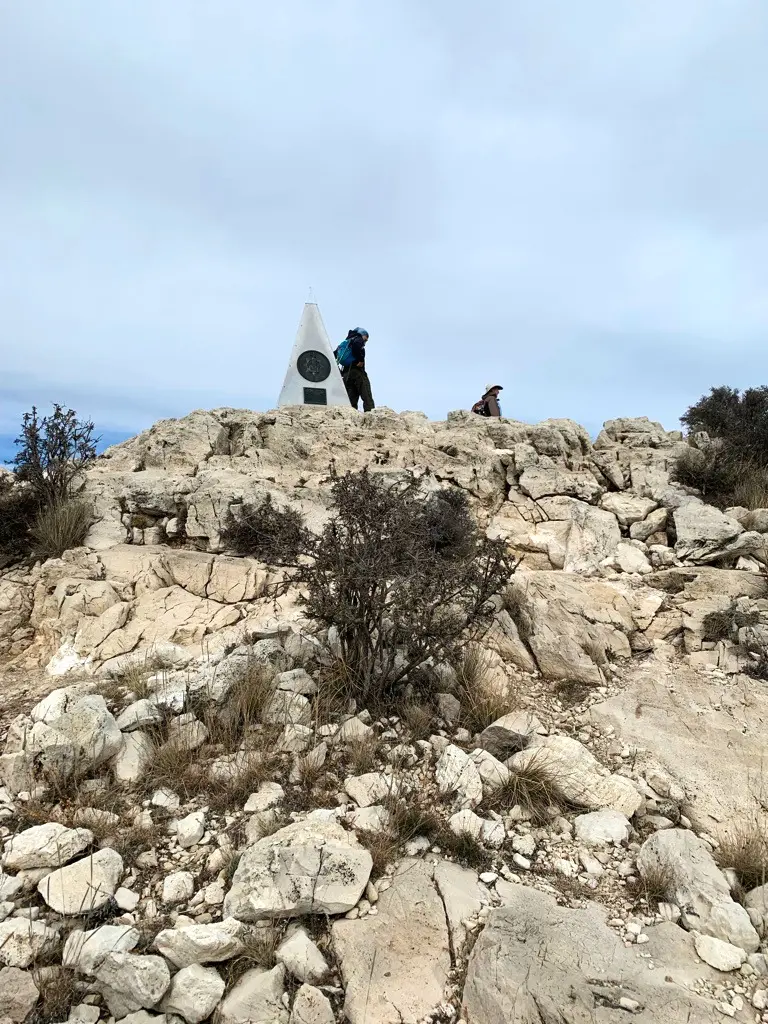One bucket list item for Guadalupe Mountains National Park is to hike Guadalupe Peak. This trail takes you to the “Top of Texas”, which is the highest point in the entire state of Texas. Hiking this trail is a huge accomplishment, but it’s not an easy trail and you may be wondering if you should even try it.
I hiked this trail on my visit to Guadalupe Mountains and it was one of the hardest hikes I’ve done. In this post, I’m going to cover everything I learned from hiking this trail so you can make an informed decision if you can handle the hike to Guadalupe Peak.

Getting to the Trail
Guadalupe Peak is located within Guadalupe Mountains National Park. Specifically it is located in the Pine Springs Area. There is parking at the trailhead, but overflow parking is located a 0.5 mile walk away at the Pine Springs Visitor Center. Further overflow parking is located another 0.5 miles away. If you’re here in peak season, make sure to get here early. If you don’t, you may have to add up to two extra miles to your hike.
When I hiked in mid November, I arrived at 8:30 on a Sunday and had no problem getting a parking spot. However I have read other blogs that mentioned getting there at 7:30 and getting the last spot.
Guadalupe Peak Hike
The trail to Guadalupe Peak is listed as 8.4 miles. I logged 8.7 miles on the day I hiked. But it’s not just the distance that makes this trail difficult. Over those 8.7 miles, I logged 2,969 feet of elevation gain. Nearly all of it was in the first 4.3 miles of the hike.
Here’s my full breakdown of the hike to the “Top of Texas” at Guadalupe Peak.

Mile 1
738 feet of elevation gain – 50 minutes
Many people consider the first mile of the trail to Guadalupe Peak the hardest. I’m not sure if I agree with that. It is difficult, but I did find this to be more because of the rocky, uneven terrain.
If you get to the end of the first mile and you are struggling, you will really want to reconsider this hike. It just gets harder as the day goes on. If you turn back at this point, there are some easier hikes you can do from the same area of the park.
Mile 2
676 feet of elevation gain – 47 minutes
This mile is easier than the first mile, but I still wouldn’t say it was easy. The first half of this mile follows the same type of terrain as the first mile. However, once you reach the end of this mile, the trail becomes easier. You’ll still be climbing, but the surface is smooth and that makes it so much easier.
Mile 3
636 feet of elevation gain – 41 minutes
This is the easiest mile of the hike up to Guadalupe Peak. It’s very smooth, so even though you’re still climbing, you don’t have to focus as much on where you’re stepping. This was probably the most enjoyable mile of the entire uphill portion of this hike.
Toward the end of this mile, you’ll likely start to feel exhausted from climbing. By the end of mile 3, you’ll have gained 2000 feet of elevation.

Mile 4
486 feet of elevation gain – 44 minutes
The rocky terrain picks up again, making this section more difficult. By this point, you’re reaching higher and higher elevations and you’re at over 8,000 feet.
Now, some people may say that it’s not that bad. I live in Wisconsin where the highest point in the entire state is at only 1900 feet. For those of us not used to being that high, you may struggle a little here. I personally found myself having to stop every few steps just to catch my breath. The higher I got, the harder it was to breathe.
For me, this was the hardest portion of the trail to Guadalupe Peak. The rocky terrain, the elevation, and the exhaustion from earlier climbing made this mile the most challenging.
Additionally, you know you’re getting closer, but when you look up, there’s still so much more ahead of you that it starts to mess with your head. You know you’ve been climbing but it still seems so far away.
Mile 5
400 feet of elevation gain – 61 minutes
After a strenuous hike, this is the mile where you will finally make it to Guadalupe Peak and the “Top of Texas”.
This mile includes the final summit and the start of the descent back down. I reached the submit at about 4.4 miles, so half of this mile was the final climb and the last half of this mile was the start of the descent back down. This time also includes a break at the top for photos and to call my hiking partner who turned around early. I had better service at Guadalupe Peak than I did back in the parking lot!
As you descend, watch your step. It’s rocky and it can be easy to slip. Admittedly I took longer than most people to descend, but I was just two months out from my disaster hike at Sky Pond at Rocky Mountain National Park. But thankfully, I got down safely and then it was all down hill from here.

Mile 6
33 feet of elevation gain – 36 minutes
Once you’re through the rocky section near the top, you really start making of time. Once the trail gets smoother, it becomes so much easier. Plus you’re descending so it gets even easier to breathe.
Mile 7
0 feet of elevation gain – 32 minutes
This was my fastest mile of the trail. At this point, I was just super excited to get back to the bottom of the mountain.
Mile 8
3 feet of elevation gain – 40 minutes
The rocky section picks up again, so I moved a bit slower here. Towards the end of this mile, you start getting glimpses of the parking lot. That’s a great morale booster after a long hike.

Mile 9
0 feet of elevation gain – 34 minutes
This “mile” was only 0.7 miles, but you’re back in the intense rocky section of the trail. I definitely found myself slowing down. I was exhausted and I found myself sliding on some of the rocks. This is a section where I really needed to focus, which can be difficult when you’re exhausted from the rest of the hike. But eventually, you get down to the bottom of the mountain and reach the trailhead. Holy crap, I actually did it! I completed a successful hike to Guadalupe Peak.
Total Stats
Length: 8.7 miles
Elevation: 2,969 feet
Time: 6 hours 40 minutes and 42 seconds (approximately 4.5 hours up and 2.25 hours down)
Some Thoughts on My Time
I feel like I’m an average hiker. Typically when I hike, I’ll look at what the estimates for a particular hike. I’ve found that I’m pretty close to that estimate. The NPS estimates 6 to 8 hours to complete this hike, so my time was almost exactly in the middle. Not too bad!
However, it should be noted that I did take fewer breaks than I normally would. I ended up hiking to the top solo (more on this later) and I didn’t want to make my hiking partner wait too long for me. Plus, I didn’t spend a lot of time on the top of Guadalupe Peak. Had I taken more breaks and spent more time at the top, I think seven hours is a reasonable estimate, which is the exact middle of the NPS estimate.

How Hard Is it to Hike Guadalupe Peak?
Given all of that, I can with certainty that Guadalupe Peak in Texas is the hardest hike I’ve done. This includes my hike to Sky Pond at Rocky Mountain National Park where I dislocated my knee with four miles to go. I hiked the last four miles of that trail on a recently “re”-located knee.
On the trail to Guadalupe Peak, the constant climbing is exhausting and the terrain forces you to pay more attention. Plus once you get towards the top, the altitude can make it harder (if you’re not used to hiking at that high altitude).
I started the hike with a partner. After the first mile and a half, they decided they were not going to make it and turned around. This was a great decision for them and one that other people should consider if they find themselves struggling in the first two miles. After they turned around, I hiked the rest of the trail solo. However, since I knew they would be waiting for me at the bottom, I pushed myself to finish quicker (hence my limited breaks).

How Fit Do You Need To Be?
You should be a reasonably fit person before doing this hike. For the last several years, I had focused on moving more and consistently hitting 10,000 steps per day (which is not always easy as someone who works from home). In the months leading up to this trip, I focused on eating healthier, losing weight, and hiking longer distances. I lost nearly 40 pounds between booking this trip and taking this trip. I feel confident in saying that I don’t think I would have made it had I done this hike before that lifestyle change.
If it helps anyone else get motivated, the thing that finally kicked me into gear was reading a comment on a hiking post on Reddit. I don’t recall the exact wording and I can no longer find the comment, but the gist was “You can wait until you get hiking to lose the weight, but if you lose the weight before you start, that’s twenty fewer pounds that you have to carry up the mountain”.
Now, let’s get back to talking about the hike to Guadalupe Peak. At an absolute minimum, you need to be able to hike 9 flat miles while carrying a daypack. Leading up to this trip, my travel plans involved a lot of hiking across Colorado, Appalachia, and here in Texas. Leading up to all of these trips, I focused on taking longer walks around my neighborhood. Most lasted 4 to 5 miles, but I tried to throw in some longer hikes as well. My longest hike was just under ten miles.
If you live in an area where you can add in hills, add some of those in. If you live somewhere flat (like me!), focus on distance but add in whatever hills you can find. You’ll be doing a lot of climbing as you hike Guadalupe Peak so you want to be as ready as you can. The elevation is the trickiest piece to train for, and unless you live somewhere that has access to hiking at that altitude, there’s not much you can do. Focus on distance and hills because that is what you’ll need the most. The elevation didn’t become an issue for me until mile 4.

What To Pack
You’ll need to carry a daypack so you can have all of your supplies with you.
At minimum, you’ll need to carry water. The amount you need depends heavily on the person and the time of year you hike. In summer, the NPS recommends carrying 4 liters of water per person.
In mid November, I carried 2 liters, kept another bottle in the car for after, and drank additional water on the way to Guadalupe Mountains National Park to make sure I started off my day properly hydrated. This was sufficient for me on that particular day. However, if it’s hot or you know that you drink a lot of water while hiking, carry more. There is nowhere to get additional water on the trail, so you only have what you carry.
Snacks are another good thing to carry. You’ll burn a lot of calories and you’ll want to make sure you have enough energy to get back down the mountain.
Carry layers. It was downright cold on the top of Guadalupe Peak. When I started the hike, everyone on the trail kept stopping to take off layers. By the time I got to the top, I was reaching for my gloves to keep my hands warm.
Trekking poles are a really great idea. I only used one trekking pole (since I loaned the other to my hiking partner). For parts of the hike, this was ok, but there were definitely some sections where I really wished I had both poles. While I passed one hiker who was complaining about carrying her trekking poles, I would not have made it to the top had I not had them.

The Trail to Guadalupe Peak
The trail is very easy to follow. There was only one section where I had to stop at think because the trail wrapped around the side of a mountain and it wasn’t immediately obvious where it went, but it was still not hard to follow.
This is one of the most popular trails at Guadalupe Mountains and there were plenty of people out hiking. Many people passed me since they were faster hikers, but I never felt completely alone of the trail.
Should You Hike Guadalupe Peak?
In the end, choosing to hike to Guadalupe Peak in Texas depends on the person. I’m glad I did it and am proud of my accomplishment, but I have absolutely no desire to do this trail again. The views are great, but it was a very difficult hike and one that I am just not keen to do again. There are other long hikes that I’d much rather do a second time.
If you do decide to do it, know your limits. It’s better to turn around if you do not think you can make it, than to push on and have to get rescued off the mountain. My hiking partner hiked the first mile and started thinking she wouldn’t be able to do it. She hiked the next half mile and then decided with certainty that she wouldn’t be able to make it. For her, turning around was the best decision. Do not be afraid to make that decision.
Finally, if you decide to do it, make sure you are prepared. Happy hiking!
Continue Your Adventure
Guadalupe Mountains National Park: Guadalupe Peak is just one of many hikes found at Guadalupe Mountains National Park.
New Mexico: There are two great national parks in New Mexico. Visit the deepest cave in the US at Carlsbad Caverns. At White Sands National Park, scenic drives and hikes are just some of the top things to do. Start your planning with this one day itinerary for White Sands.
Itineraries: In one five day road trip, you can visit White Sands, Carlsbad Caverns, and Guadalupe Mountains National Parks.
More Long Distance Hikes: If you like long distance hikes, check out Sky Pond at Rocky Mountain National Park. Or in try the Porters Creek Trail at Great Smoky Mountains National Park.
US National Parks: Start planning your national park vacation with my US National Park Travel Guide. You’ll find information about each park, photos, itineraries, budget tips, advice for non-hikers, the best scenic drives, and more. Plus, don’t forget to book your timed entry reservations in advance!
